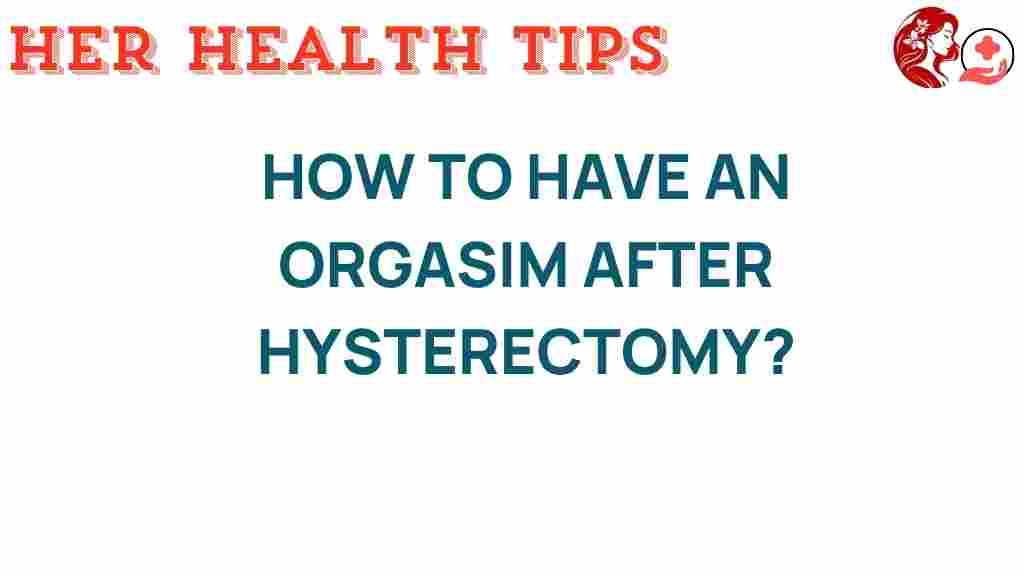Rediscovering Pleasure: How to Achieve Orgasm After Hysterectomy
Undergoing a hysterectomy can be a transformative experience for many women, often arising from medical necessity due to conditions such as fibroids, endometriosis, or cancer. While this procedure can be life-saving, it can also lead to significant changes in sexual health and intimacy. Many women wonder how to achieve orgasm after hysterectomy, and it is essential to understand that pleasure is still attainable. In this article, we will explore the connection between hysterectomy and sexual wellness, offering insights and practical tips for rediscovering desire and intimacy after surgery.
Understanding Hysterectomy and Its Impact on Sexual Health
A hysterectomy involves the surgical removal of the uterus, and sometimes other reproductive organs. This procedure can be performed for various reasons, including:
- Uterine fibroids
- Endometriosis
- Uterine prolapse
- Cancer or pre-cancerous conditions
Following a hysterectomy, many women report changes in their sexual health, including:
- Altered sensation in the pelvic area
- Vaginal dryness
- Changes in libido or desire
- Difficulty achieving orgasm
Understanding these changes is the first step in navigating the journey towards rediscovering pleasure and intimacy post-surgery.
Step-by-Step Process to Achieve Orgasm After Hysterectomy
Achieving orgasm after hysterectomy is possible with patience, understanding, and the right strategies. Here is a comprehensive guide to help you on your journey:
1. Prioritize Recovery and Self-Care
After a hysterectomy, your body needs time to heal. Focus on your recovery by:
- Following your doctor’s post-operative care instructions
- Engaging in light physical activity as recommended
- Eating a balanced diet to support healing
- Staying hydrated
Taking care of your overall wellness will lay the groundwork for a healthy sexual recovery.
2. Communicate with Your Partner
Open communication with your partner is vital for rebuilding intimacy. Discuss your feelings, desires, and any concerns regarding sexual activity. Here are some points to consider:
- Share your emotional state and how the hysterectomy has affected you
- Discuss any physical discomfort or changes in sensation
- Explore new ways to connect intimately that may not involve penetration initially
This dialogue fosters understanding and can significantly enhance your intimate experiences.
3. Explore Your Body
After surgery, it’s essential to reconnect with your body. Consider exploring through:
- Self-examination to understand changes in sensation
- Gentle massage of the pelvic region
- Kegel exercises to strengthen the pelvic floor muscles
These activities help you tune into your body and rediscover pleasure.
4. Use Lubrication
Vaginal dryness is a common issue following hysterectomy. Using a high-quality lubricant can enhance comfort and pleasure. Options include:
- Water-based lubricants
- Silicone-based lubricants
- Natural oils, such as coconut oil
Experiment with different types to find what feels best for you.
5. Gradual Reintroduction to Intimacy
Start slowly when reintroducing sexual activity. Consider these tips:
- Begin with non-penetrative activities, such as kissing and cuddling
- Incorporate sensual touch and foreplay to build arousal
- Gradually progress to penetration only when you feel comfortable
Listen to your body and go at your own pace to prevent discomfort.
6. Focus on Emotional Intimacy
Emotional connection plays a crucial role in sexual satisfaction. Engage in activities that strengthen your bond, such as:
- Spending quality time together
- Engaging in shared hobbies or interests
- Practicing mindfulness or relaxation techniques together
These practices can enhance your emotional intimacy, which may lead to greater sexual satisfaction.
7. Seek Professional Guidance
If you continue to experience challenges achieving orgasm after hysterectomy, consider consulting a healthcare professional, such as:
- Your gynecologist
- A sexual health therapist
- A pelvic floor physical therapist
These professionals can provide tailored advice and interventions to improve your sexual health.
Troubleshooting Tips for Sexual Health After Hysterectomy
It’s normal to face some difficulties as you navigate your sexual health after a hysterectomy. Here are some troubleshooting tips:
1. Addressing Pain During Intercourse
If you experience pain during intercourse, consider the following:
- Ensure adequate arousal and lubrication
- Experiment with different positions that may be more comfortable
- Communicate with your partner about what feels good and what doesn’t
Consult a professional if the pain persists, as it may indicate an underlying issue.
2. Managing Changes in Libido
Changes in desire after hysterectomy can be disheartening. To help manage libido fluctuations:
- Focus on stress reduction techniques, such as yoga or meditation
- Engage in regular physical activity to boost endorphins
- Consider hormone therapy if recommended by your doctor
3. Understanding Orgasm Changes
Some women report changes in the intensity or experience of orgasms after hysterectomy. To navigate this:
- Experiment with different types of stimulation, such as clitoral or vaginal
- Incorporate sex toys to enhance pleasure
- Practice relaxation techniques to reduce anxiety around orgasm
Remember that every woman’s experience is unique, and it may take time to find what works for you.
Conclusion: Embracing Your Sexual Health Journey
Rediscovering pleasure and achieving orgasm after hysterectomy is a journey that requires patience, understanding, and communication. By prioritizing recovery, exploring your body, and fostering emotional intimacy, you can navigate this new chapter in your sexual health with confidence. Remember, it’s essential to listen to your body and seek professional help if needed. Embrace this opportunity to reconnect with your desires and enhance your overall wellness.
For more information on women’s health and sexual wellness, consider visiting this resource. If you’re looking to deepen your understanding of pelvic health, check out this guide.
This article is in the category Reproductive and created by HerHealthTips Team
